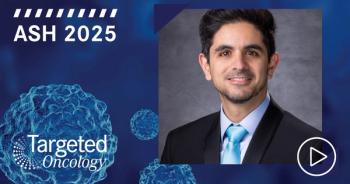
NCCN Recommendations on Adjuvant and Neoadjuvant Treatments for GIST
In this video, Edwin Choy, MD, discusses the NCCN Clinical Practice Guidelines for treating gastrointestinal stromal tumors.
Edwin Choy, MD, director of the Sarcoma Program at the Division of Hematology Oncology at Massachusetts General Hospital, a founding member of Mass General Brigham, associate professor of medicine at Harvard Medical School, explains the National Comprehensive Cancer Network (NCCN) Clinical Practice Guidelines for the treatment of gastrointestinal stromal tumors (GIST).
Largely, the guidelines leave room for oncologists to make their own decision about which treatment strategies are best for their patients., explain Choy. However, the guidelines do make important recommendations on the timing of treatment, and which treatments offer optimal outcomes for patients at different stages of disease. For example, Choy says that avoid serious surgery is ideal for some patients but is necessary for others.
The guidelines also provide detailed information about which treatment are better in the neoadjuvant setting versus the adjuvant setting.
TRANSCRIPT:
0:08 | In terms of neoadjuvant therapy, [recommendations are] broad, largely because we want to leave it up to the judgment of the clinicians. For example, if a GIST is located in the stomach close to the esophagus, sometimes in order to get a complete resection, we will have to perform a total gastrectomy. Patients who have had total gastrocnemius have a very awkward lifestyle in terms of how much they can eat, and what their life looks like without a stomach. To avoid a total gastrectomy, I would give neoadjuvant imatinib to shrink the tumor, downstage it, and make the resection more possible for a partial gastrectomy, which has a much better lifestyle than someone with a total gastrectomy.
1:17 | The guidelines start by saying if GIST is resectable but has significant morbidity, such as a total gastrectomy, then they recommend mutation testing. The mutation testing would let us know how sensitive the tumor would be to one of our various drugs used to treat it. Depending on the mutation profile, if the mutation profile shows a tumor sensitive to imatinib, then it's reasonable to give maybe 6 months of preoperative imatinib therapy to downstage the tumor and make it more easily removable.
2:03 | In the guideline, it also talks about how we can use different agents depending on what the tumor DNA sequencing results show. If the results show a mutation called D842V in PDGFRA, then those tumors would be uniquely sensitive to a drug called avapritinib [Ayvakit], which was designed with this mutation in mind. If the tumor had a mutation in NTRK, there are a number of commercially available NTRK inhibitors that have a good chance of creating a response in a tumor.
AI For young patients, their GIST tends to be wild-type, meaning they don't have an obvious mutation in either KIT or PDGFR, and in those patients, they usually have a deletion and SDH, so we call them SDH deficient GIST. For those patients, there aren't many great treatments for them. Of the available GIST drugs, we think that sunitinib may work better on these tumors than the other tyrosine kinase inhibitors. The NCCN recommends either using sunitinib or a clinical trial, or to try to get them to surgery. The NCCN recommends different agents depending on the molecule profile. In terms of clinical management, there's only a role for neoadjuvant therapy if it makes the surgery better.









































